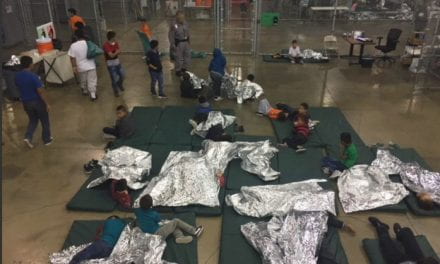Climate change is one of the most pressing issues to date, impacting nearly every aspect of life. Climate change has influenced numerous national and international decisions regarding energy production, agriculture, and development. Though permanent effects of climate change are still being determined by climate experts, many are suggesting that the international community will be crossing a point of no return in the next few decades. Even if states manage to curb greenhouse gas emissions and prevent the warming of the Earth by 1.5 degrees Celsius, various regional areas are still projected to experience catastrophes such as prolonged drought, excessive flooding, desertification, and rising sea levels.[1] Such catastrophes can induce mass displacement and result in the transnational movement of people.
Though not officially defined, recognized, or protected under international law, the United Nations High Commissioner for Refugees (UNHCR) acknowledges the plight of so-called “climate refugees,” or “persons displaced in the context of disaster and climate change,” that are forcibly removed from their place of habitual residence.[2] As the climate crisis continues to unfold, it is revealing the world’s most vulnerable populations, particularly those of island nations who may be forced to flee as their environment becomes more hostile to human life. But what if after fleeing to a second-country those citizens of island nations suddenly find themselves with no hospitable place to return? What if the climate crisis evolved to its most extreme point and submerged entire states under water?
Such questions have been of increasing interest amongst refugee rights coalitions and low-lying island states. Though small island developing states (SIDS) such as Maldives, Kiribati, and Vanuatu are collectively responsible for less than one percent of the entire world’s carbon emissions, such regions are bearing the brunt of the climate crisis to the extent that their islands could become unable to sustain human life or completely submerged by the end of the 21st century.[3] Though states have the ability to dissolve or “die” to form new state entities, such low-lying islands may physically cease to exist due to climate change, leaving behind no practical successor state for its citizens.
Even if climate change did not reach this extreme, the unlivable conditions wrought by climate change could force people to flee abroad wherein extended absence from one’s home country can result in a passive loss of citizenship.[4] Climate change therefore not only has the potential to trigger mass forced migration, but the unprecedented ability to render whole populations stateless and without a country to call home. Without careful consideration of climate change and its implications for statelessness, the international community may have yet another humanitarian catastrophe on its hands wherein millions are cast outside the international state system.
Statelessness and Climate Change in Small Island Developing States
As defined by the 1954 Convention Relating to the Status of Stateless Persons, a stateless person is someone who “is not considered to be a national by any State under the operation of its law.”[5] A person can become stateless by a variety of means, the most common of which include state succession or dissolution. In such cases, one state ceases to exist and is replaced by one or more successor states in its place, as observed with the collapse of the Soviet Union in 1991 and Yugoslavia in 1992. As new state boundaries and nationality policies emerge, some people find themselves unable to obtain citizenship of the country to which they feel that they belong.[6] Additional factors that increase the chances for statelessness include: forced migration; administrative difficulties in obtaining state-issued identity documents, such as a birth certificate; or nationality laws that prevent certain persons from obtaining or conferring nationality on the basis of gender, religion, ethnicity, or race.[7]
Statelessness is a violation of internationally recognized norms and rights. Article 15 of the United Nations Universal Declaration of Human Rights (UDHR) states that “everyone has the right to a nationality” and shall not be “arbitrarily deprived of [their] nationality, nor prevented from obtaining a new one.”[8] Yet, the presence of an estimated 10 million stateless people exist across all seven continents and without this vital right recognized.[9] Life without a nationality invites further human rights complications, as no state in the world is legally obliged to protect and administer rights or services to the stateless person. The consequences for stateless persons range from the minute, everyday inconveniences to more grave violations—such as genocide—that can be prosecuted in the International Court of Justice (ICJ). Being stateless often means that one lives without any state-provided documents, such as driver’s licenses, birth certificates, and passports, which makes them more vulnerable to human trafficking.[10] In some countries, it also means that one’s right to be treated equally as a person before the law (UDHR Article 6), the right to basic education (UDHR Article 26), and the right to marry (UDHR Article 16) are severely hampered. As theorized by political theorist Hannah Arendt (who herself was stateless for nearly ten years), “statelessness became equated with rightlessness,” as the human being had to seek the protection and administration of their rights through the nation-state.[11]
Multiple agencies have highlighted how climate change serves as a “risk multiplier” for statelessness.[12] In a 2021 draft report on the impacts of climate change on migration, the Biden-Harris Administration highlighted how prolonged climate-related displacement heightened chances for intergenerational statelessness due to the loss of identity documents and prolonged presence out of one’s home country.[13] However, alarm bells on climate-induced statelessness have been ringing for well over a decade. In 2011, the UNHCR highlighted that the continued rise in sea levels has the potential to submerge island territories—partially or entirely—and create environments unable to sustain adequate standards of living.[14] The emerging, dominant narrative surrounding these island nations and its citizens in the wake of climate change is near apocalyptic, deeming SIDS “vanishing islands” and “disappearing states.”[15]
The total disappearance of island states—either by loss of physical land due to rising sea levels or displacement on such a scale that an entire state’s population is no longer present on said physical land—should be one of the largest concerns for the international community in relation to climate change. Part of the issue rests with the international definition of what constitutes a state entity. Though considered outdated by some, most international law scholars adhere to the 1933 Montevideo Convention when defining a state. Under this Convention, four general criteria must be met in order for a party to be considered a State at the international level: a population, territory, a government, and the capacity to enter into relations with other states.[16]
The first two Montevideo requirements of population and territory are of the utmost concern when discussing the consequences of climate change on statelessness. As sea levels rise, low-level island states will undoubtedly lose physical land. The Intergovernmental Panel on Climate Change (IPCC) lists the worst-case scenario of sea level rise at one meter (thirty-six inches) by the end of the 21st-century, but other studies claim a much higher sea level rise at three meters (118 inches) due to rapid melting of the Antarctic ice sheets.[17] Though these numbers appear insignificant in ordinary contexts, sea level rise at this level has the potential to devastate territories with an altitude lower than ten meters above sea level. Currently, there are three states that have an altitude of ten meters or less that have the potential of becoming entirely submerged within a century: the Maldives (five meters/180 inches), Tuvalu (four meters/144 inches), and the Marshall Islands (ten meters/360 inches).[18] Another two states, Nauru and Kiribati, have been listed as states that have the potential to cause statelessness due to the fact that rising sea levels could create lands incapable of supporting adequate standards of living, particularly through the introduction of salinated seawater to freshwater drinking sources and agricultural plains.[19]
The projected loss of land and ability to sustain human life for some island states raises the issue of population. If conditions continue to deteriorate, more than half of an island state’s permanent population could migrate abroad. However, some argue that population and territory should be inextricably “interlinked” and that a “significant portion” of the population must permanently reside on the land in order for a state to remain a state and uphold territorial integrity, as required by the Montevideo Convention.[20] The idea of an interlinkedness between a permanent citizen population and land raises important questions on the nationality status of those whose homes have either become modern-day Atlantises or incompatible with human habitation: if the physical land of the state disappears, does that state still exist in the international system? Even more pressing, do nationals of that country lose their citizenship, effectively making them stateless?
These questions raise the issue of state extinction itself. As Park notes, any time in modern history where a state entity has ceased to exist, there was a successor state immediately taking its place. The disappearance of whole states with no apparent successor to its remaining population has been unheard of prior to the early-to-mid 2000s.[21] Though Park and other scholars recommend that states can rule from another location as a non-state entity, international law scholars suggest that effective governance (meaning the capacity to protect and defend its people) would be severely limited— a state would no longer be a state if it could not rule over and protect its nationals. As climate-induced statelessness is an unprecedented phenomena, it is unclear whether or not a nation-state can retain its statehood if its territory is either submerged or uninhabitable, thus placing SIDS and its citizens into a precarious legal (and physical) dilemma.[22]
Conclusion and Considerations: What Can Be Done to Prevent Climate-Induced Statelessness?
The UNHCR should partner with climate change activists, scholars, and states to not only ensure that climate refugees are able to find protection, but to take preventative measures to make certain that climate-induced statelessness does not become a reality. First and foremost, the UNHCR should partner with other relevant UN Agencies to spread relevant information on anthropogenic climate change and its risks for increasing statelessness and displacement. By amplifying the expertise from UN bodies such as the IPCC, the UNHCR may be able to encourage member-states to adhere to best practices on reducing carbon emissions and prevent further ozone deterioration.
Second, the UNHCR should work with state governments to create policies that are inclusive and accepting of persons displaced by climate change, especially those who may be at risk of losing part or all of their home state. As noted earlier, the international definition of a refugee under the 1951 Refugee Convention does not officially recognize climate change as a means for refugee status to be granted to an applicant. In most contemporary scholarship, those seeking refugee status must demonstrate a “well founded fear of being persecuted” on the basis of race, religion, nationality, membership of a particular group and must be unwilling to obtain protection from said country.[23] However, some argue that the phrase “unable to return,” as stated in Article 1(A)(2) of the 1951 Convention, makes room for a certain class of stateless refugees who are not persecuted.[24] The UNHCR, along with relevant stakeholders and partners, should consider broadening its application and usage of the term ‘refugee’ to ensure that all persons at risk of climate-induced statelessness have a pathway to protection.
Statelessness is but one of the many potential consequences of climate change that requires collaboration and consideration from the international community writ large. Particularly for citizens of small island developing states, the prospect of becoming stateless looms large without concrete action plans to curb the effects of climate change, or coordination between states to provide protection for those on the move. To ensure that states uphold everyone’s right to a nationality,[25] it is imperative that future climate change policies be considered through the lens of migration and statelessness.
[1] International Panel on Climate Change, “Summary for Policymakers,” In Global Warming of 1.5°C: An IPCC Special Report on the impacts of global warming of 1.5°C above pre-industrial levels and related global greenhouse gas emission pathways, in the context of strengthening the global response to the threat of climate change, sustainable development, and efforts to eradicate poverty [Masson-Delmotte, V., P. Zhai, H.-O. Pörtner, D. Roberts, J. Skea, P.R. Shukla, A. Pirani, W. Moufouma-Okia, C. Péan, R. Pidcock, S. Connors, J.B.R. Matthews, Y. Chen, X. Zhou, M.I. Gomis, E. Lonnoy, T. Maycock, M. Tignor, and T. Waterfield (eds.)]. World Meteorological Organization, Geneva, Switzerland, 32 pp.
[2] United Nations High Commissioner for Refugees, “Climate change and disaster displacement,” https://www.unhcr.org/en-us/climate-change-and-disasters.html.
[3] UN News, “Sink or swim: Can island states survive the climate crisis?” UN News, July 31, 2021, https://news.un.org/en/story/2021/07/1096642.
[4] UNHCR, Peter McMullin Center on Statelessness, and the Norwegian Refugee Council, “Statelessness and Climate Change Factsheet,” October 2021, https://www.refworld.org/docid/617c01da4.html.
[5] UN Treaty Collection, “1954 Convention Relating to the Status of Stateless Persons,” September 29th, 1954.
[6] UNHCR and Open Justice Society, “Citizens of Nowhere: Statelessness in the United States,” December 2012, https://www.unhcr.org/en-us/about-us/background/56fbfcea4/citizens-of-nowhere-solutions-for-the-stateless-in-the-us.html.
[7] Institute on Statelessness and Inclusion, “The World’s Stateless,” Refworld, December 2014, 23-27, https://www.refworld.org/docid/617c01da4.html; The White House, “Report on the Impact of Climate Change on Migration,” October 2021, 20, https://www.whitehouse.gov/wp-content/uploads/2021/10/Report-on-the-Impact-of-Climate-Change-on-Migration.pdf.
[8] United Nations General Assembly, Resolution 217(A), December 10, 1948, https://www.un.org/en/ga/search/view_doc.asp?symbol=A/RES/217(III).
[9] Petra Nahmias, “Better Statistics to Help End Statelessness,” UNHCR Blogs, January 21, 2020, https://www.unhcr.org/blogs/better-statistics-to-help-end-statelessness/.
[10] United States Department of State, “2021 Trafficking in Persons Report,” June 2021, https://www.state.gov/wp-content/uploads/2021/09/TIPR-GPA-upload-07222021.pdf.
[11] Hannah Arendt, The Origins of Totalitarianism, (New York: Meridian Books, 1951).
[12] UNHCR et al, “Statelessness and Climate Change Fact Sheet,” October 2021.
[13] The White House, “Report on the Impact of Climate Change,” 20.
[14] Susan Park, “No. 20: Climate Change and the Risk of Statelessness: The Situation of Low-Lying Island States.” United Nations High Commissioner for Refugees, May 2011, https://www.unhcr.org/en-us/protection/globalconsult/4df9cb0c9/20-climate-change-risk-statelessness-situation-low-lying-island-states.html.
[15] Lilian Yamamoto and M. Esteban, “Vanishing Island States and Sovereignty,” Ocean & Coastal Management 53, no. 1: 1–9. https://doi.org/10.1016/j.ocecoaman.2009.10.003.
[16] Jan Klabbers, “International Law: Third Edition,” Cambridge: Cambridge University Press, 2021, 75.
[17] Etienne Piguet, “Climatic Statelessness: Risk Assessment and Policy Options,” Population and Development Review, 45(4) 2019, 869.
[18] Ibid.
[19] Ibid.
[20] Jan Klabbers, “The Subjects of International Law,” in International Law, 3rd ed. (Cambridge University Press: 2021), 75-79, Kindle.
[21] Park, “Climate Change and the Risk of Statelessness,” 6; Jane McAdam, “‘Disappearing States’: Statelessness and the Boundaries of International Law,” UNSW Law Research Paper No. 2010-2 (January 2010), 1-2.
[22] Michel Rouleau-Dick, “Sea Level Rise and Climate Statelessness,” The Statelessness & Citizenship Review, 3, no. 2 (2021), 286-308. Retrieved from https://statelessnessandcitizenshipreview.com/index.php/journal/article/view/271.
[23] UNTC, “1951 Convention Relating to the Status of Refugees,” July 28, 1951, https://treaties.un.org/pages/ViewDetailsII.aspx?src=TREATY&mtdsg_no=V-2&chapter=5&Temp=mtdsg2&clang=_en.
[24] Heather Alexander and Jonathan Simon, “‘Unable to Return’ in the 1951 Refugee Convention: Stateless Refugees and Climate Change,” Florida Journal of International Law 26(3) (2015), 1-28.
[25] United Nations General Assembly, Resolution 217(A), December 10, 1948, https://www.un.org/en/ga/search/view_doc.asp?symbol=A/RES/217(III).







